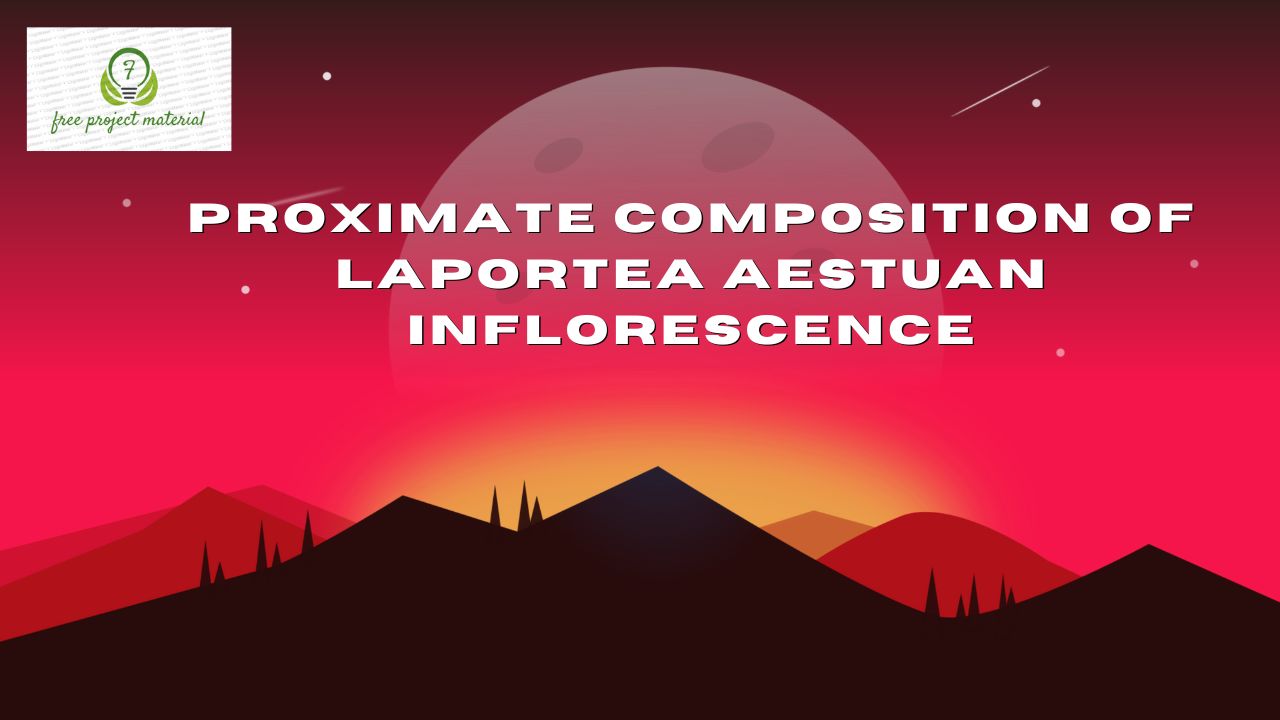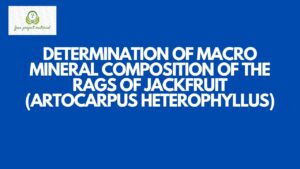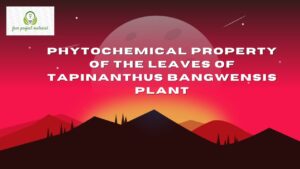ABSTRACT
Proximate analysis of fresh inflorescence of Laportea aestuan (Ntan) was carried out using standard analytical procedure recommended by AOAC, 2017. The result shows that fresh inflorescence contained 31.08 ± 0.11 moisture, 7.10 ± 0.09, ash, 1.47 ± 0.05, fat, 3.61 ± 0.61, crude fibre, 0.75 ± 0.09, crude protein, 87.37 ± 0.09 carbohydrate respectively and 365.62 ± 0.17 Kcal/100g caloric value. The result obtained above showed that fresh inflorescence of Laportea aestuan has appreciable quantities of the nutrient analysed such as carbohydrate, moisture, ash and caloric value but relatively high fat, crude fibre and protein content. The result of the analysis are discussed.
TABLE OF CONTENTS
TITLE PAGE – – – – – – – –
CERTIFICATION – – – – – – – ii
DEDICATION – – – – – – – iii
ACKNOWLEDGEMENTS – – – – – iv
ABSTRACT – – – – – – – v
TABLE OF CONTENTS – – – – – – vi
CHAPTER ONE: INTRODUCTION
1.1 Background of the Study – – – – – – 1
1.2 Aim and Objectives of the Study – – – – 2
1.3 Scope and Limitation – – – – – – 3
CHAPTER TWO: LITERATURE REVIEW
2.1 Description of Laportea aestuan – – – – 4
2.2 Wild Vegetables – – – – – – – 4
2.3 Chemical and Nutritional Value of Wild Vegetables – 6
2.3.1 Health Benefits of Wild Vegetables – – – – 7
2.3.2 Proximate Composition – – – – – – 7
2.3.3 Moisture – – – – – – – – 8
2.3.4 Ash Content – – – – – – – – 8
2.3.5 Crude Fat – – – – – – – – 9
2.3.6 Carbohydrate – – – – – – – 10
2.3.7 Caloric Value – – – – – – 11
2.3.8 Crude Fibre – – – – – – – – 12
2.3.9 Crude Protein – – – – – – – 12
2.3.10 Ash – – – – – – – – – 14
CHAPTER THREE: MATERIALS AND METHODS
3.1 Materials – – – – – – – – 15
3.1.1 Collection and Preparation of Sample – – – – 15
3.2 Methods – – – – – – – – 15
CHAPTER FOUR: RESULTS AND DISCUSSION
4.1 Results – – – – – – – – 24
4.2 Discussion – – – – – – – – 25
CHAPTER FIVE: CONCLUSION AND RECOMMENDATIONS
5.1 Conclusion – – – – – – – – 28
5.2 Recommendations – – – – – – – 28
References
CHAPTER ONE: INTRODUCTION
1.1 Background of the Study
Plants are important in our everyday existence. They provide our food, produce the oxygen we breath and serve as raw material for many industrial products such as cloths, foot wears and so many others. Plants also provide raw materials for our buildings and in manufacture of biofuels, perfumes, pesticides and drugs.
The use plants in traditional medicinal practice has a long drawn history and remains the mainstay of primary health care in most of the third world. Traditional medicines are used by about 60% of the world population in both developing and developed countries where modern medicines are predominantly used (Mythilypriya et al., 2007). An estimated 60-80% Africa’s population depends solely on herbal remedies for its primary health care needs.
Indiversity, plants are thought to be between 250,000 to 400,000 species spread across all continents from Antarctic to the Arctic. They thrive in all environment from the flooded plains to the deserts and from those who lives on the seas and ocean to others that thrive on fresh water and ponds. For classification and easy identifications, plants were divided into different taxonomical groups known as kingdoms, these are further stream line into phylum, class, order, family, genus and species. Within the family of Urticaceae is found an amazing plant called the (Laportea aestuan) west indian wood nettle. The present study assaged the proximate composition of L. aestuan .
Laportea aestuans is widely distributed in tropical Asia, tropical Africa (Clifford and Chimera, 2012), and throughout the Eastern and Western hemisphere tropics and subtropics, West indies, Central America, Sumatra, India and Java.
1.2 Aim and Objectives of the Study
1.2.1 Aim
The present study aimed at evaluating the proximate composition of L. aestuans inflorescence.
1.2.2 The Objectives of this Study were:
- To determine the moisture content in Laportea aestuan
- To determine the ash content in Laportea aestuan
- To determine the crude fat in Laportea aestuan
- To determine the crude fibre in Laportea aestuan
- To determine the crude protein in Laportea aestuan
- To determine the carbohydrate in Laportea aestuan
- To determine the caloric value in Laportea aestuan
1.3 Scope and Limitation of the Study
This study only focused on the proximate composition of L.eastuan due to the financial constraint and the level of study.



